Illustrating a Hay Meadow: The Commission
A recent commission to illustrate a hay meadow landscape down on the coast of Devon was a wonderful job. The client is North Devon Area of Natural Beauty (NDAONB) and the illustration will be used on an interpretation board on site.
Currently, the area is scrub land; it’s over-grazed and needs managing for wildflowers and wildlife. Which is where my illustration comes in. Based closely on the present view across Bentham bay, my task was to illustrate an idealised hay meadow full of wild flowers and animals. In amongst there are a few unusual species (such as the Brown Carder Bee Bombus humilis) which NDAONB are rightly proud of and keen to encourage.
Although the area may never look as extreme as my illustration, with careful management NDAONB have good reason to believe a healthy and vibrant hay meadow community is only a few years away.
Pencil Rough
As always, the first step is to put together all the elements in a composition which flows. This often involves using birds in the sky as framing devices, and making sure longer grasses remain on the edges, encouraging your eye to move across the landscape.
From the thumbnail, I work up a much more detailed pencil rough, starting with the background landscape, then plotting in the animals, and finally filling the spaces between with appropraite wild flower species.
I always send client annotated pencil roughs to ensure every species they wanted to include has been accounted for.

Annotated Pencil Rough of Bentham Coastal Hay Meadow Landscape
Painting the Landscape
Once I get the go-ahead, I begin by adding the sky. This is a very wet wash that covers the entire sheet of paper except for the animals in the foreground. It helps unite the painting.
Next, I paint the background landscape, keeping the colours pale and the contrast limited. This ensures that when completed the animals grab your attention, and there’s a feeling of depth to the hay meadow landscape. This part of the illustration doesn’t really get noticed when it’s complete, but it often takes longer than the details of the plants and animals.
I also pop in the tractor (compete with a grumpy farmer). I love painting slightly unusual things, and the tractor and hay bales were a lot of fun.
The sky and background normally take about a day; working on the shrubs and trees will take at least another full working day.
Illustrating the Hay meadow flora
Now come the wild flowers. I work from left to right so I avoid leaning on completed work. I also lean on a big sheet of paper so that the unpainted area remains clean as I paint.
The flowers in this hay meadow include clover, common orchid, yellow rattle (an indicator of healthy meadow land), rest harrow, bedstraw, knapweed, milk thistle, various grass species, buttercup, tormentil, and ox-eye daisy. I was lucky enough to visit the Bentham meadow site so could add species I found growing there to the existing plant list.
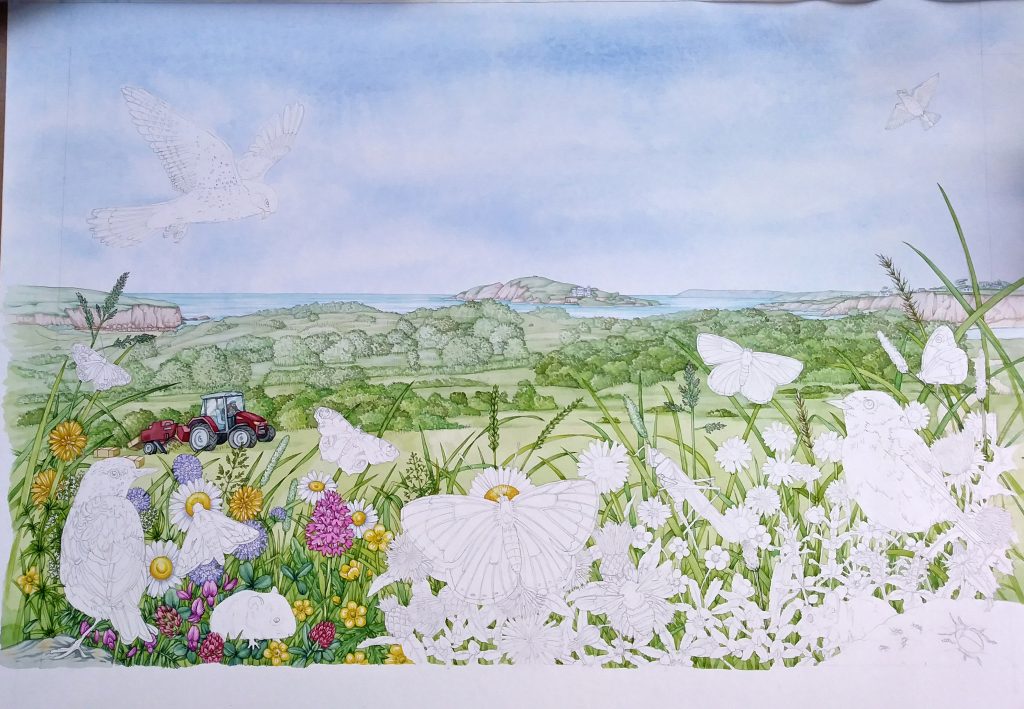
Work in Progress: Painting the wild flowers
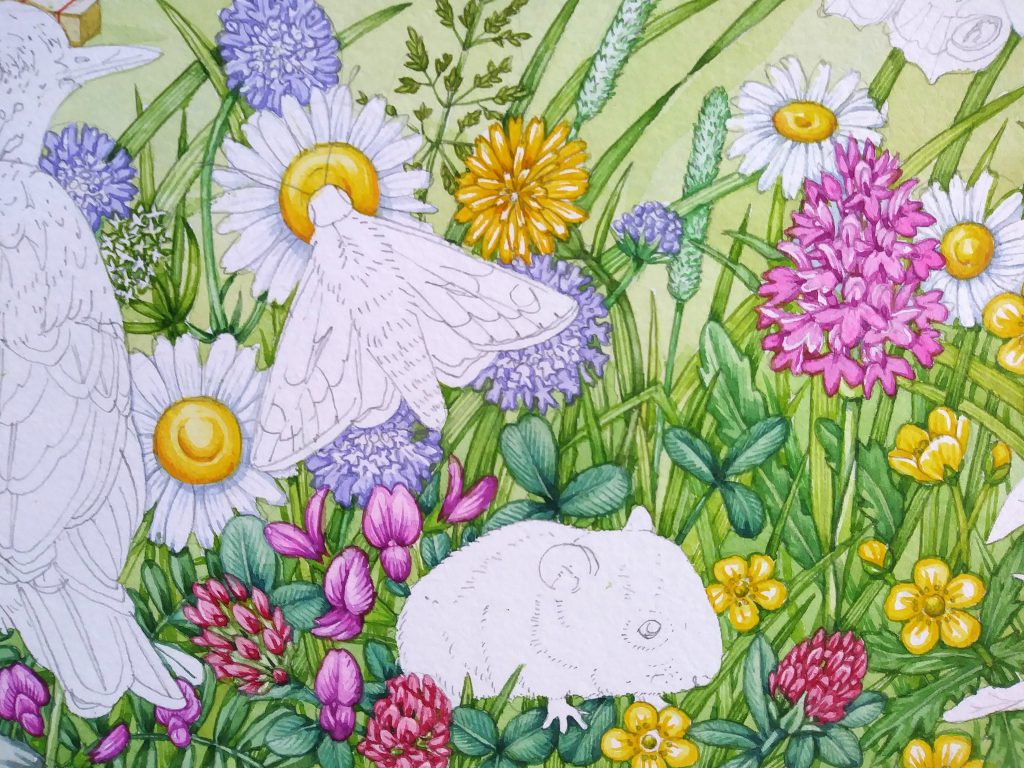
Close up of the illustration showing the blues in the Clover leaves and the pink Restharrow flowers
I love this stage, how the white spaces where the animals will go start to pop out at you. One of my friends described it as looking like a sticker-book, waiting for a child to pop the right colourful sticker onto the right line drawing.
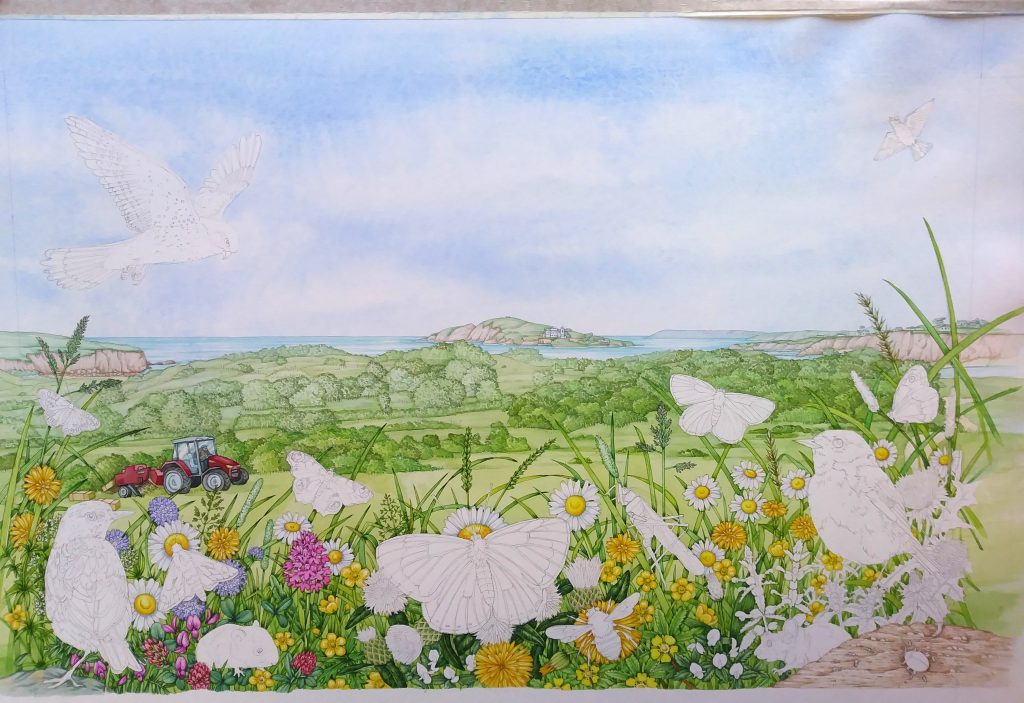
Getting there: Working into the leaves
I tend to paint the leaves first, then treat myself to the brightly coloured flowers. You can see this in the photo above, the yellow flowers are completed but the pinks, purples and reds await my ministrations.

Some plants are trickier than others; the Yellow rattle (unpainted, left hand side) has pale leaves and chalky yellow petals. It also has very pale green calyx flushed crimson. Yellow rattle often gets left until last.

This is a similar view, but the Self heal and Yellow rattle have been added.
Adding the flowers on a large landscape like this (60 cm across) takes a couple of days.
Adding the animals to the Hay Meadow landscape
Once the flowers and foliage are in I re-visit them with some dark purples and blues, picking out the shadows and trying to add depth to the undergrowth. This stage takes a long time and involves a lot of getting very close, then standing well back from the illustration.
I love this stage of a landscape illustration, It’s like being a child in a sweet shop. Only the animals left to paint in, and they are FUN.
As with the plants, I tend to work from left to right. I’ll also do any animals in the sky first. Getting the edges of a bird or butterfly wrong can spell disaster as it’s much harder to hide mistakes in a clean blue sky than it is to fudge and fix amongst swathes of leaves and flowers.
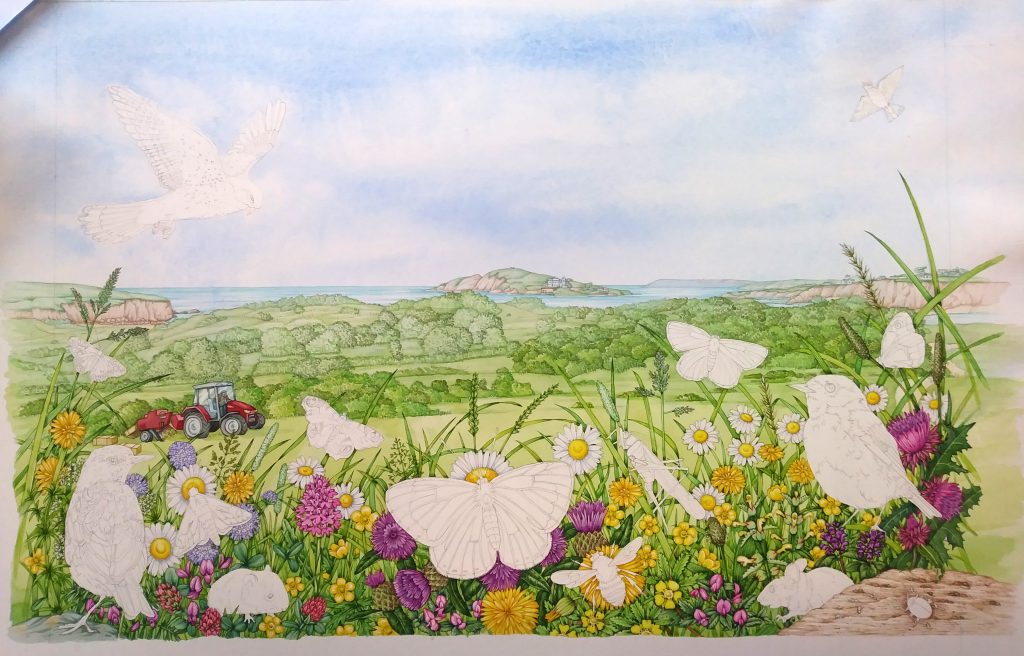
Hay Meadow Landscape with background and wild flowers completed.
Birds and Butterflies in the sky
The kestrel will be a familiar motif to those of you who read my blogs regularly, as will the lark. I have used the same reference and position for these species over and over again, mostly in these landscapes. You can find this Kestrel (flipped) in my Malham cove landscape, and the lark appears in my BBC Wildlife magazine Hay meadow cross-section. It also appears (flipped) in my illustration of a Hen harrier hunting red grouse.
There are several repeated animals that come up, I do a good line in repeating swallows and I’m pretty sure the Large Skipper has featured before (possibly in that same BBC Wildlife Hay meadow). My philosophy is, “why change it if it works?”. However, I digress.
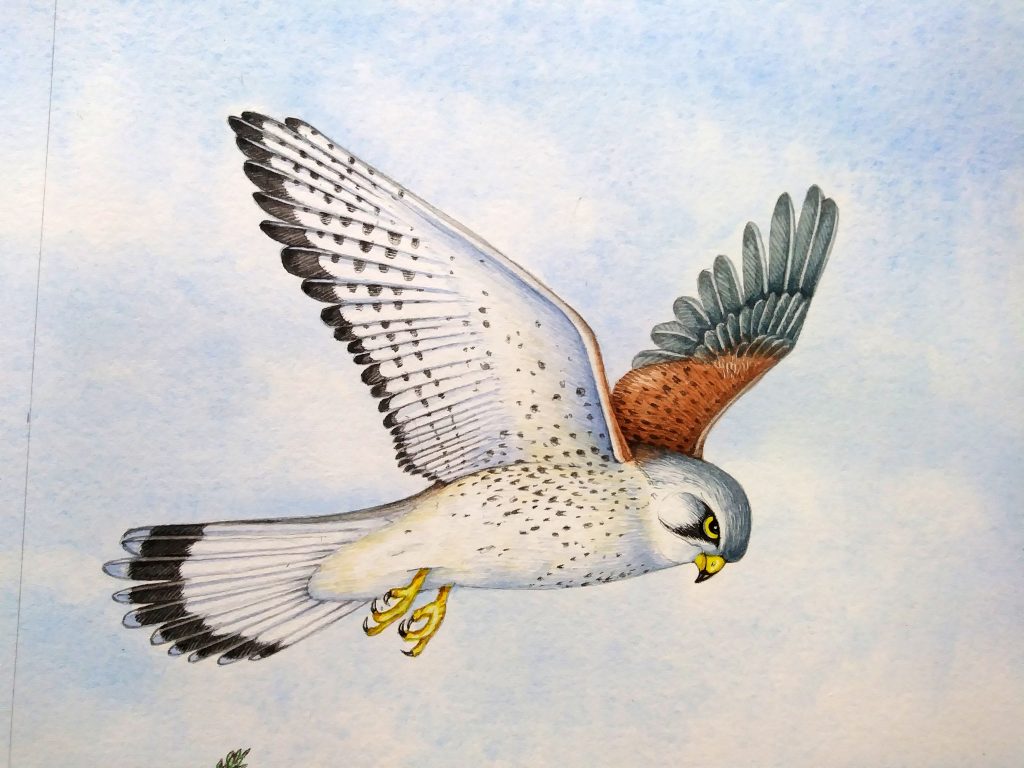
Kestrel Falco tinnunculus
Adding Animals at Ground level
Moving from left to right, down at ground level we have the Rock Pipit and Large Skipper done and dusted. The bank vole was made easier as I have a specimen in my freezer (for more on this habit of hanging onto road kill and prizes from cats, please look at my Youtube video: Birds, Bugs and Bodies in the Freezer). This means colour matching the fur is much easier.

My dear friend costumier Wendy Harrup gave me an old Victorian butterfly cabinet, so getting the colours right on the lepidopteran specimens is so much better than it used to be. Working from photos and illustrations is helpful if you can’t access a specimen (see my blog for more on this), but having the actual plant or animal there in front of you is infinitely preferable. It’s so much easier!
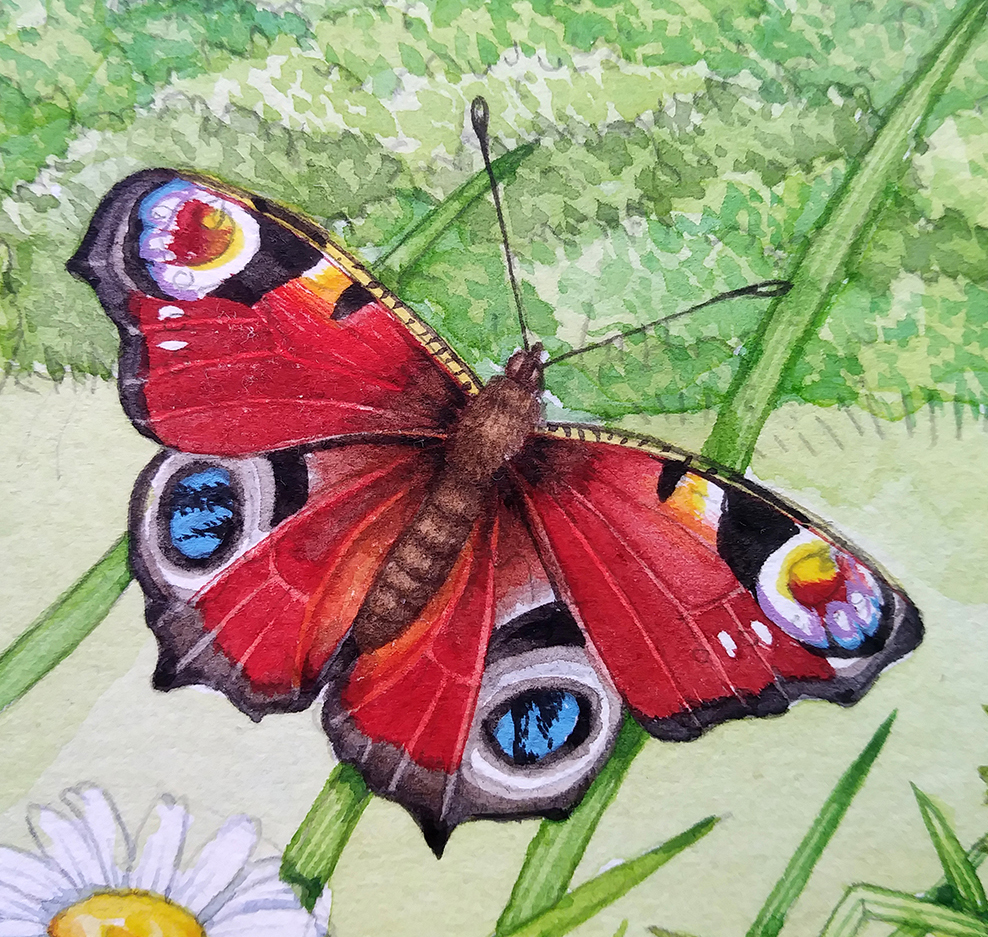
Here’s the Peacock butterfly, Aglais io, much enlarged.
I illustrate butterflies by leaving their wing veins as white til near the end. A top wash knocks the veins back and adds structure and depth to the wing form.
The main focus of the whole illustration is the big female Holly Blue. She needs to be good, or the entire illustration will fail. I take my time with the centre-stage species, and spend longer on them than on the other animals. Building up the black wing edges with lots of tiny brush strokes is always rewarding and helps to make her feel clean and crisp.

Holly blue Celastrina argiolus butterfly
It took nearly two days working on the animals to get to this stage.
The homeward stretch
At this point I start counting down how many animals I have left to paint, and postulating as to when the illustration might be completed. I thought it would take two more days from this point, but it went smoothly and was complete in one.

Animals on the left remain to be “coloured in”. I start with the Brown Carder bee, then move onto the Great Bush Cricket and the male Holly Blue.
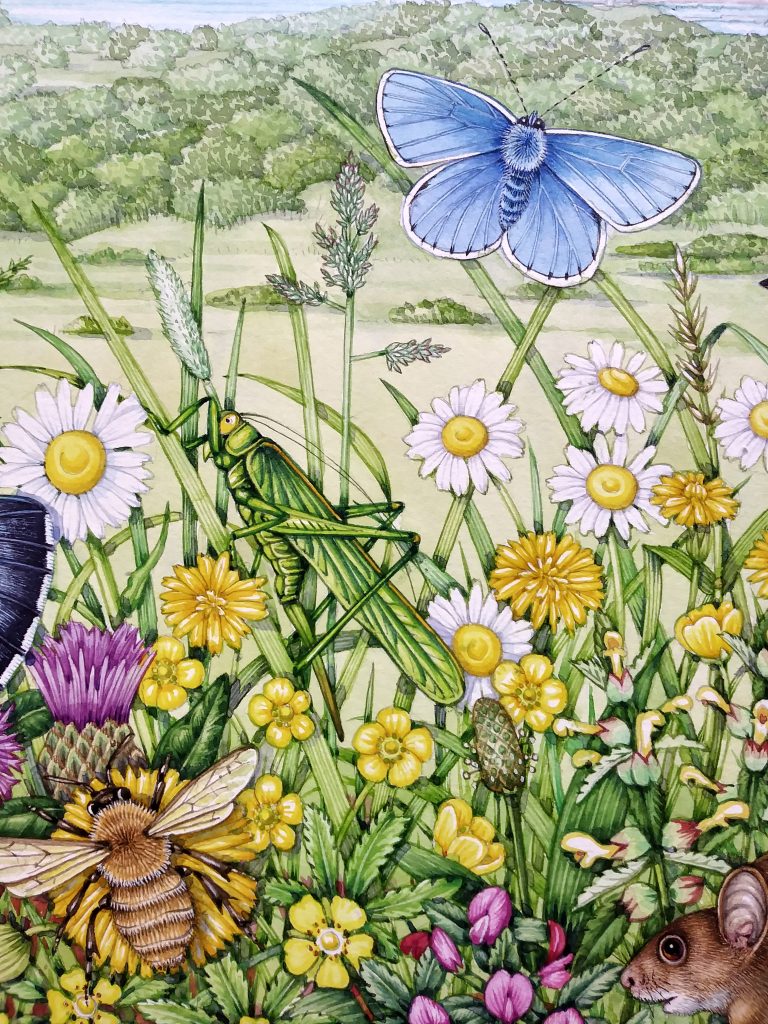
Brown carder bee Bombus humilis, Great Bush Cricket Tettigonia viridissima, and male Holly Blue Celastrina argiolus
One of the effects I love about these hay meadow landscapes is that animals who are well camouflaged in life become equally well disguised in an illustration. The cricket seems to disappear in the grass and leaves.
A couple more butterflies are added without mishap, and the Wood mouse is completed (and slightly wide eyed).

Wood mouse Apodemus sylvaticus
The final animal to add is the Stonechat Saxicola rubicola. I properly love these birds. When I walk along the coast in Pembrokeshire, they’re always in evidence. They flutter from gorse bush to gorse bush, chittering and flittering. I find them most endearing, and very beautiful. Painting them is lovely, and mixing that rich brick red is always a joy (especially after so much green and blue!).
Balancing Reds in the composition
In this illustration, the Stonechat is really important structurally. The red on his chest needs to be there to draw the eye across the page, and balance out the red tractor and the Peacock butterfly. All these things have to be considered at the thumb nail stage. Unfortunately there’s a slight disconnect between the crimson of the tractor and Peacock butterfly, and our Stonechat. Adding a tiny bit of crimson to his chest and eye helps, but it doesn’t quite swing it.
Were I to repeat this illustration, I’d make certain there was another crimson flower or animal firmly on the right hand side of the painting. You can see where I’ve tried to balance the crimson by adding it to the inner petals on the small milk thistle below his tail, and to the stems of the self heal plant. There’s a lot of this trickery that goes on in these landscapes; hopefully it’s subtle enough for the viewer not to notice.
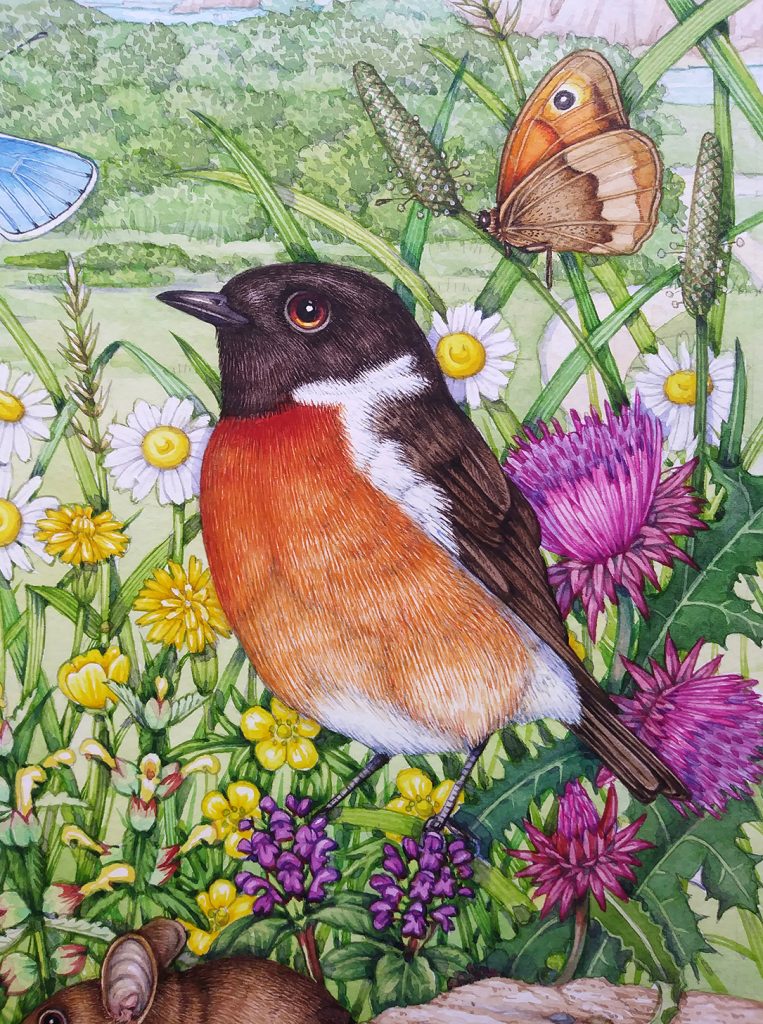
Detail of the completed Stonechat, Saxicola rubicola
Finishing up
The final touches involve mixing up some more purple and blue, and tweaking the darkest areas of shadow. I also make a far more dilute mauve and add the shadows to the landscape, below the trees. You can decide what time of day the illustration is at this point – I tend to go for a late afternoon with the shadows just starting to lengthen. 3.30pm-ish.
Next, I cut the landscape free from the board it was stretched on, wrap it as best I can, and take it to my wonderful local printers to be scanned. Then it’s just a matter of invoicing the client (who has paid and claims to be delighted – phew), and adding this landscape to the list of unframed original illustrations I have available for sale. This one is £275 (unframed), about 60 cm x 40 cm, and is ready for immediate dispatch if you fancy it!
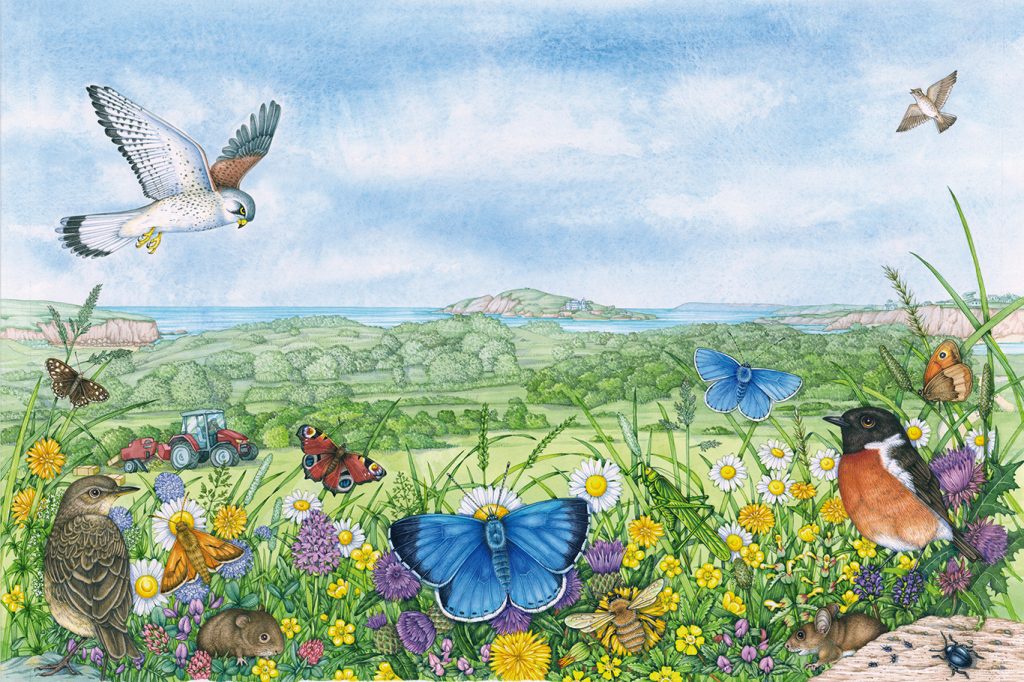
The post Illustrating a Coastal Hay Meadow Landscape appeared first on Lizzie Harper.






